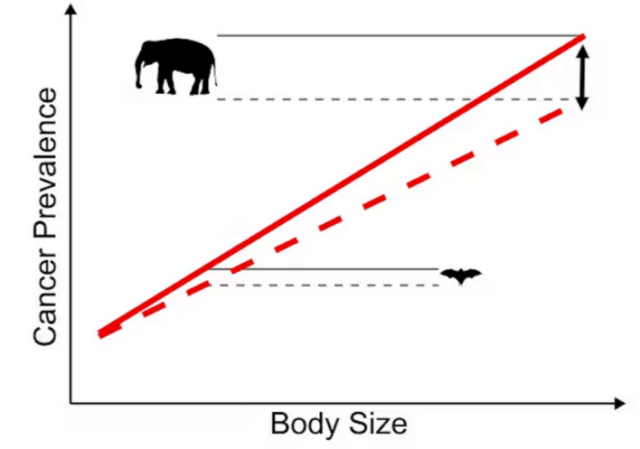A longstanding scientific belief about a link between cancer prevalence and animal body size has tested for the first time in our new study ranging across hundreds of animal species.
If larger animals have more cells, and cancer comes from cells going rogue, then the largest animals on Earth—like elephants and whales—should be riddled with tumours. Yet, for decades, there has been little evidence to support this idea.
Many species seem to defy this expectation entirely. For example, budgies are notorious among pet owners for being prone to renal cancer despite weighing only 35 g. Yet cancer only accounts for around 2 percent of mortality among roe deer (up to 35 kg).
Peto’s paradox is that bigger, longer-lived species should have higher cancer prevalence, yet they don’t seem to. Back in 1977, Professor Sir Richard Peto noted that, on a cell-by-cell basis, mice seem to have much higher susceptibility to cancer than humans. This has led to speculation that larger species must have evolved natural cancer defenses.
Several examples of these cancer defenses have since been identified. For example, Asian elephants, a species with notably low cancer prevalence, have over 20 copies of a tumour suppressor gene (TP53) compared to our own lone copy. However, scientists are yet to find broader evidence across a range of animal species.
Our new study challenges Peto’s paradox. We used a recently compiled dataset of cancer prevalence in over 260 species of amphibians, birds, mammals, and reptiles from wildlife institutions. Then, using powerful modern statistical techniques, we compared cancer prevalence between the animals.

We found that larger species do, in fact, have more cancer compared to smaller ones. This holds across all four major vertebrate groups, meaning that the traditional interpretation of Peto’s paradox doesn’t hold up. But the story doesn’t end there.
At first look, our findings seemed to be at odds with another long-standing scientific idea. Cope’s rule is that evolution has repeatedly favored larger body sizes, because of advantages like improved predation and resilience. But why would natural selection drive species toward a trait that carries an inherent risk of cancer?
The answer lies in how quickly body size evolves. We found that birds and mammals that reached large sizes more rapidly have reduced cancer prevalence. For example, the common dolphin, Delphinus delphis evolved to reach its large body size—along with most other whales and dolphins (referred to as cetaceans) about three times faster than other mammals. However, cetaceans tend to have less cancer than expected.
Larger species face higher cancer risks but those that reached that size rapidly evolved mechanisms for mitigating it, such as lower mutation rates or enhanced DNA repair mechanisms. So rather than contradicting Cope’s rule, our findings refine it.
Larger bodies often evolve, but not as quickly in groups where the burden of cancer is higher. This means that the threat of cancer may have shaped the pace of evolution.
Humans evolved to our current body size relatively rapidly. Based on this, we would expect humans and bats to have similar cancer prevalence, because we evolved at a much, much faster rate. However, it is important to note that our results can’t explain the actual prevalence of cancer in humans. Nor is that an easy statistic to estimate.
Human cancer is a complicated story to unravel, with a plethora of types and many factors affecting its prevalence. For example, many humans not only have access to modern medicine but also varied lifestyles that affect cancer risk. For this reason, we did not include humans in our analysis.
Fighting cancer
Understanding how species naturally evolve cancer defences has important implications for human medicine. The naked mole rat, for example, is studied for its exceptionally low cancer prevalence in the hopes of uncovering new ways to prevent or treat cancer in humans. Only a few cancer cases have ever been observed in captive mole rats, so the exact mechanisms of their cancer resistance remain mostly a mystery.
At the same time, our findings raise new questions. Although birds and mammals that evolved quickly seem to have stronger anti-cancer mechanisms, amphibians and reptiles didn’t show the same pattern. Larger species had higher cancer prevalence regardless of how quickly they evolved. This could be due to differences in their regenerative abilities. Some amphibians, like salamanders, can regenerate entire limbs—a process that involves lots of cell division, which cancer could exploit.
Putting cancer into an evolutionary context allowed us to reveal that its prevalence does increase with body size. Studying this evolutionary arms race may unlock new insights into how nature fights cancer—and how we might do the same.
Joanna Baker, Postdoctoral Researcher in Evolutionary Biology, University of Reading and George Butler, Career Development Fellow in Cancer Evolution, UCL. This article is republished from The Conversation under a Creative Commons license. Read the original article.